Thomas Cook: Tourism Consumer Behaviour and Decision Making Analysis
VerifiedAdded on 2023/01/19
|14
|4524
|77
Report
AI Summary
This report provides a comprehensive analysis of tourism consumer behavior, examining the cultural, social, personal, and psychological factors that influence consumer attitudes within the tourism context. It explores the impact of digital technology on changing consumer trends, including the rise of online information, wearable tech, cruise holidays, eco-friendly options, and long-haul travel. The report delves into the consumer decision-making journey, mapping the path to purchase for tourism services and highlighting the importance of understanding consumer behavior for marketers. It also compares and contrasts B2C and B2B hospitality decision-making processes and evaluates various market research approaches. Furthermore, the report assesses how marketers can influence the different stages of the tourism decision-making process, providing specific examples. The report utilizes Thomas Cook as a case study, analyzing its strategies within the tourism sector.
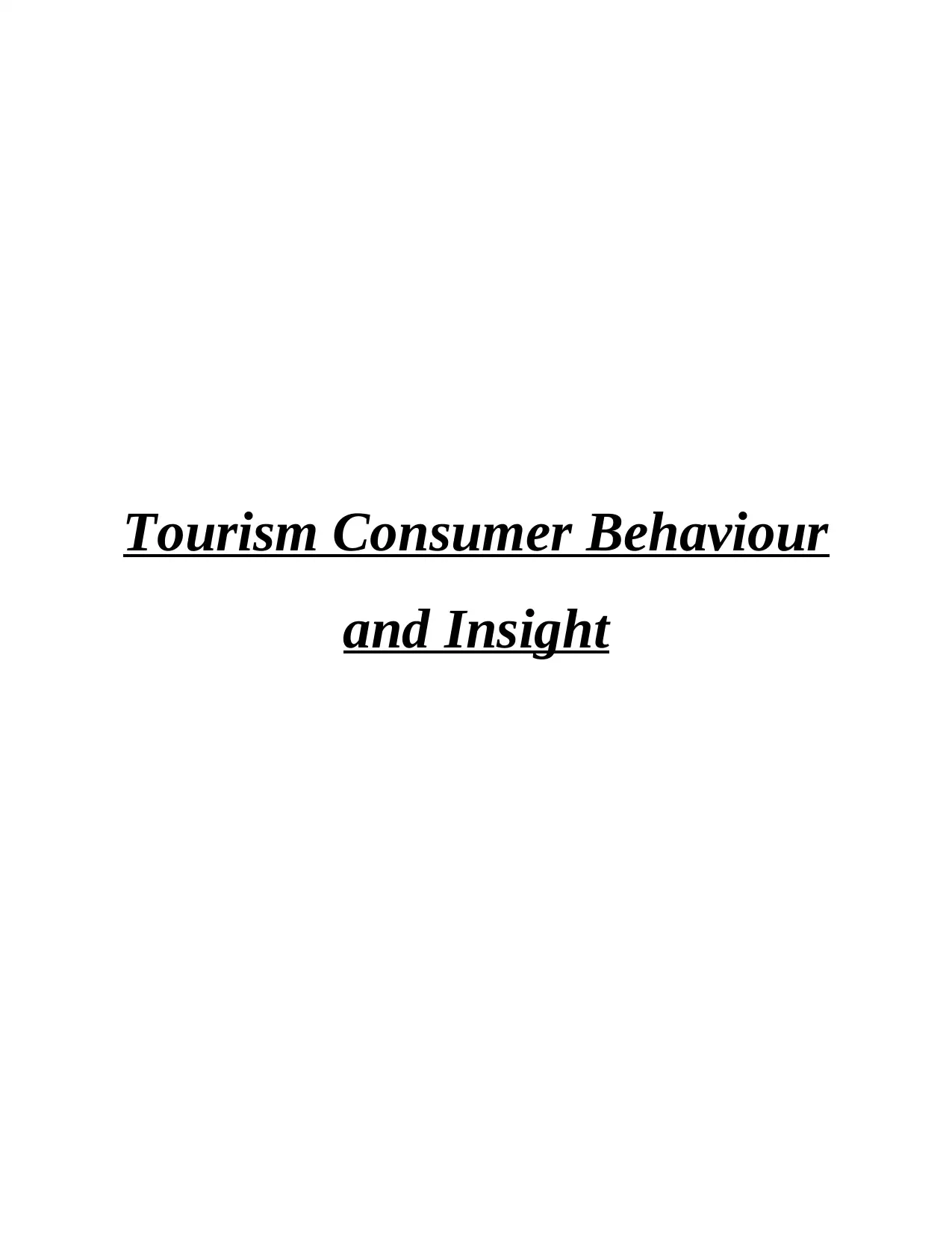
Tourism Consumer Behaviour
and Insight
and Insight
Paraphrase This Document
Need a fresh take? Get an instant paraphrase of this document with our AI Paraphraser
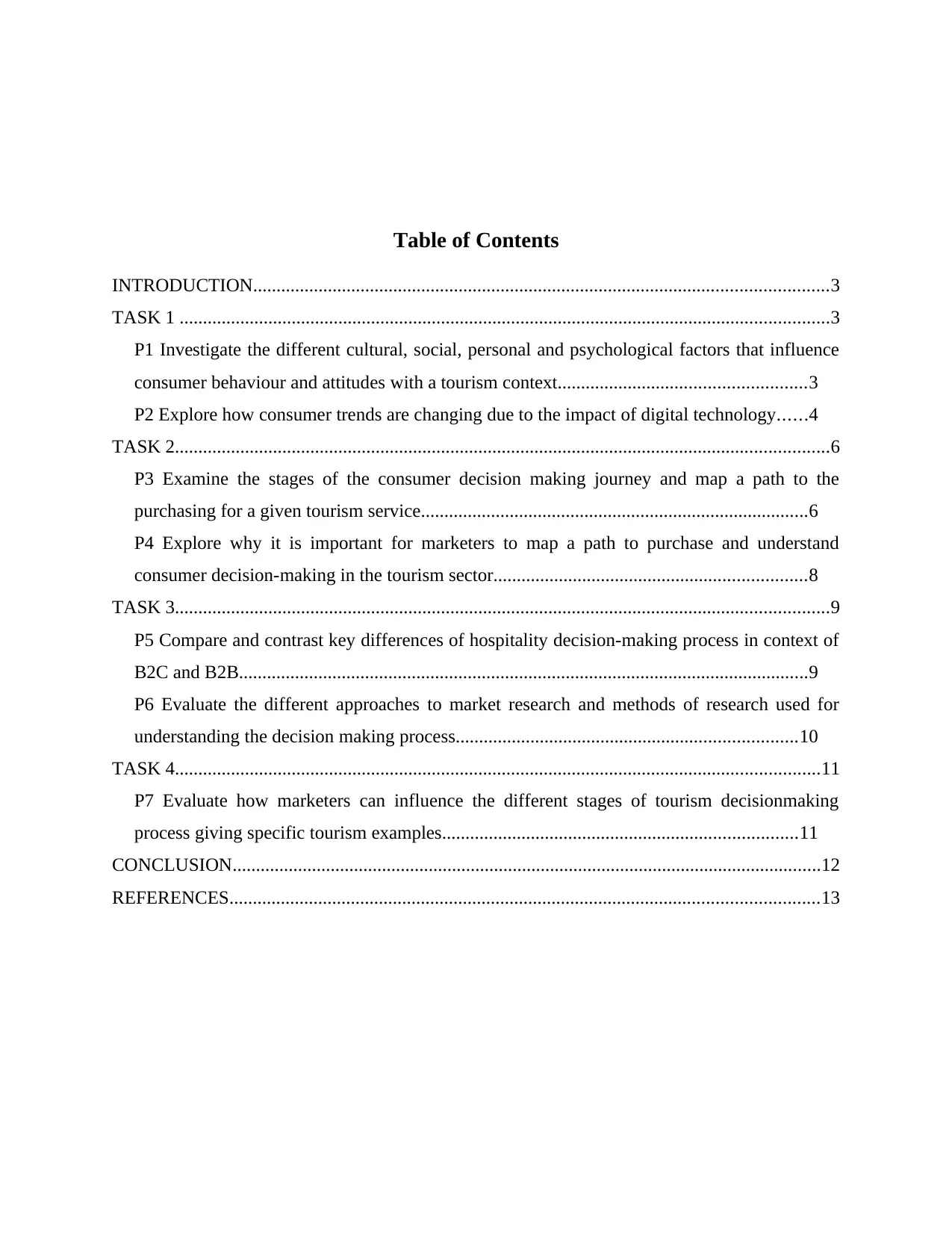
Table of Contents
INTRODUCTION...........................................................................................................................3
TASK 1 ...........................................................................................................................................3
P1 Investigate the different cultural, social, personal and psychological factors that influence
consumer behaviour and attitudes with a tourism context.....................................................3
P2 Explore how consumer trends are changing due to the impact of digital technology......4
TASK 2............................................................................................................................................6
P3 Examine the stages of the consumer decision making journey and map a path to the
purchasing for a given tourism service...................................................................................6
P4 Explore why it is important for marketers to map a path to purchase and understand
consumer decision-making in the tourism sector...................................................................8
TASK 3............................................................................................................................................9
P5 Compare and contrast key differences of hospitality decision-making process in context of
B2C and B2B..........................................................................................................................9
P6 Evaluate the different approaches to market research and methods of research used for
understanding the decision making process.........................................................................10
TASK 4..........................................................................................................................................11
P7 Evaluate how marketers can influence the different stages of tourism decisionmaking
process giving specific tourism examples............................................................................11
CONCLUSION..............................................................................................................................12
REFERENCES..............................................................................................................................13
INTRODUCTION...........................................................................................................................3
TASK 1 ...........................................................................................................................................3
P1 Investigate the different cultural, social, personal and psychological factors that influence
consumer behaviour and attitudes with a tourism context.....................................................3
P2 Explore how consumer trends are changing due to the impact of digital technology......4
TASK 2............................................................................................................................................6
P3 Examine the stages of the consumer decision making journey and map a path to the
purchasing for a given tourism service...................................................................................6
P4 Explore why it is important for marketers to map a path to purchase and understand
consumer decision-making in the tourism sector...................................................................8
TASK 3............................................................................................................................................9
P5 Compare and contrast key differences of hospitality decision-making process in context of
B2C and B2B..........................................................................................................................9
P6 Evaluate the different approaches to market research and methods of research used for
understanding the decision making process.........................................................................10
TASK 4..........................................................................................................................................11
P7 Evaluate how marketers can influence the different stages of tourism decisionmaking
process giving specific tourism examples............................................................................11
CONCLUSION..............................................................................................................................12
REFERENCES..............................................................................................................................13

INTRODUCTION
Hospitality industry is category of various fields within service that includes food, drink,
lodging and so on (Ayik, Benetatos and Evagelou, 2013). In today's era, this sector is growing at
higher speed out of which travel and tourism is the most developing field. Here, it is the
responsibility of business to provide good experience to tourist in proper manner. The
organisation chosen for assignment is Thomas Cook which was established in 1841 at London,
United Kingdom. This is British company which has two separate entity such as airline and tour
operator. In order to survive at marketplace, it is essential for service industry to provide high
quality facilities to tourism sector. The report covers factors that influence tourism consumer
behaviour and attitude along with path to purchase in tourism context for decision making
process. It also highlights about tourism consumer decision making process and their stages.
TASK 1
P1 Investigate the different cultural, social, personal and psychological factors that influence
consumer behaviour and attitudes with a tourism context
Consumer behaviour is defined as study of group, individual and organisations where
activities are related with purchase, disposal and use of product and service that includes mental,
emotional and behavioural response of users (Bruwer, Lesschaeve and Campbell, 2012). It is
very important to know about consumers so that services and goods can be provided accordingly.
Consumer attitude is defined as feeling of favourable and unfavourable decision of an individual
towards products and services. It is comprises of feeling, belief and behavioural intentions
towards things.
It is the responsibility of Thomas Cook to analyse consumer behaviour and attitude in
order to provide them service related with tourism so that they can get better experience. The
different factors that influence consumer behaviour and attitudes are described below:
Cultural Factors- This factor plays an effective role in determining consumer behaviour.
It is divided into culture, sub-culture, social class (4 important Factors that Influence Consumer
Behaviour, 2019). Under culture context, belief of human behaviour and their roles which they
play in society is included. The sub culture means people group where they share customs,
values, traditions in terms of nation, racial group, religion and so on. Similarly, social class
people focus on income level of individual. This consists of human behaviour, customs,
Hospitality industry is category of various fields within service that includes food, drink,
lodging and so on (Ayik, Benetatos and Evagelou, 2013). In today's era, this sector is growing at
higher speed out of which travel and tourism is the most developing field. Here, it is the
responsibility of business to provide good experience to tourist in proper manner. The
organisation chosen for assignment is Thomas Cook which was established in 1841 at London,
United Kingdom. This is British company which has two separate entity such as airline and tour
operator. In order to survive at marketplace, it is essential for service industry to provide high
quality facilities to tourism sector. The report covers factors that influence tourism consumer
behaviour and attitude along with path to purchase in tourism context for decision making
process. It also highlights about tourism consumer decision making process and their stages.
TASK 1
P1 Investigate the different cultural, social, personal and psychological factors that influence
consumer behaviour and attitudes with a tourism context
Consumer behaviour is defined as study of group, individual and organisations where
activities are related with purchase, disposal and use of product and service that includes mental,
emotional and behavioural response of users (Bruwer, Lesschaeve and Campbell, 2012). It is
very important to know about consumers so that services and goods can be provided accordingly.
Consumer attitude is defined as feeling of favourable and unfavourable decision of an individual
towards products and services. It is comprises of feeling, belief and behavioural intentions
towards things.
It is the responsibility of Thomas Cook to analyse consumer behaviour and attitude in
order to provide them service related with tourism so that they can get better experience. The
different factors that influence consumer behaviour and attitudes are described below:
Cultural Factors- This factor plays an effective role in determining consumer behaviour.
It is divided into culture, sub-culture, social class (4 important Factors that Influence Consumer
Behaviour, 2019). Under culture context, belief of human behaviour and their roles which they
play in society is included. The sub culture means people group where they share customs,
values, traditions in terms of nation, racial group, religion and so on. Similarly, social class
people focus on income level of individual. This consists of human behaviour, customs,
⊘ This is a preview!⊘
Do you want full access?
Subscribe today to unlock all pages.

Trusted by 1+ million students worldwide
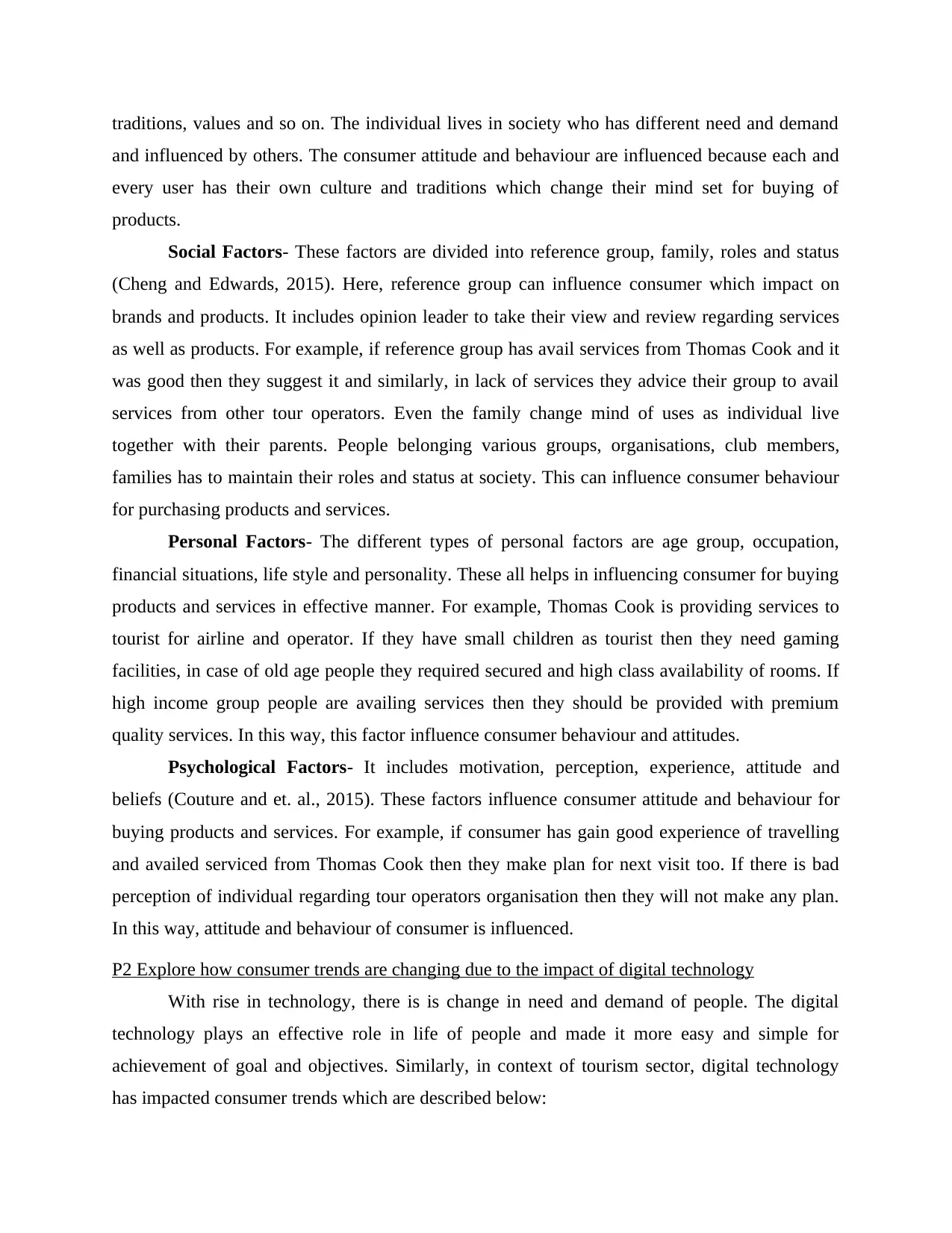
traditions, values and so on. The individual lives in society who has different need and demand
and influenced by others. The consumer attitude and behaviour are influenced because each and
every user has their own culture and traditions which change their mind set for buying of
products.
Social Factors- These factors are divided into reference group, family, roles and status
(Cheng and Edwards, 2015). Here, reference group can influence consumer which impact on
brands and products. It includes opinion leader to take their view and review regarding services
as well as products. For example, if reference group has avail services from Thomas Cook and it
was good then they suggest it and similarly, in lack of services they advice their group to avail
services from other tour operators. Even the family change mind of uses as individual live
together with their parents. People belonging various groups, organisations, club members,
families has to maintain their roles and status at society. This can influence consumer behaviour
for purchasing products and services.
Personal Factors- The different types of personal factors are age group, occupation,
financial situations, life style and personality. These all helps in influencing consumer for buying
products and services in effective manner. For example, Thomas Cook is providing services to
tourist for airline and operator. If they have small children as tourist then they need gaming
facilities, in case of old age people they required secured and high class availability of rooms. If
high income group people are availing services then they should be provided with premium
quality services. In this way, this factor influence consumer behaviour and attitudes.
Psychological Factors- It includes motivation, perception, experience, attitude and
beliefs (Couture and et. al., 2015). These factors influence consumer attitude and behaviour for
buying products and services. For example, if consumer has gain good experience of travelling
and availed serviced from Thomas Cook then they make plan for next visit too. If there is bad
perception of individual regarding tour operators organisation then they will not make any plan.
In this way, attitude and behaviour of consumer is influenced.
P2 Explore how consumer trends are changing due to the impact of digital technology
With rise in technology, there is is change in need and demand of people. The digital
technology plays an effective role in life of people and made it more easy and simple for
achievement of goal and objectives. Similarly, in context of tourism sector, digital technology
has impacted consumer trends which are described below:
and influenced by others. The consumer attitude and behaviour are influenced because each and
every user has their own culture and traditions which change their mind set for buying of
products.
Social Factors- These factors are divided into reference group, family, roles and status
(Cheng and Edwards, 2015). Here, reference group can influence consumer which impact on
brands and products. It includes opinion leader to take their view and review regarding services
as well as products. For example, if reference group has avail services from Thomas Cook and it
was good then they suggest it and similarly, in lack of services they advice their group to avail
services from other tour operators. Even the family change mind of uses as individual live
together with their parents. People belonging various groups, organisations, club members,
families has to maintain their roles and status at society. This can influence consumer behaviour
for purchasing products and services.
Personal Factors- The different types of personal factors are age group, occupation,
financial situations, life style and personality. These all helps in influencing consumer for buying
products and services in effective manner. For example, Thomas Cook is providing services to
tourist for airline and operator. If they have small children as tourist then they need gaming
facilities, in case of old age people they required secured and high class availability of rooms. If
high income group people are availing services then they should be provided with premium
quality services. In this way, this factor influence consumer behaviour and attitudes.
Psychological Factors- It includes motivation, perception, experience, attitude and
beliefs (Couture and et. al., 2015). These factors influence consumer attitude and behaviour for
buying products and services. For example, if consumer has gain good experience of travelling
and availed serviced from Thomas Cook then they make plan for next visit too. If there is bad
perception of individual regarding tour operators organisation then they will not make any plan.
In this way, attitude and behaviour of consumer is influenced.
P2 Explore how consumer trends are changing due to the impact of digital technology
With rise in technology, there is is change in need and demand of people. The digital
technology plays an effective role in life of people and made it more easy and simple for
achievement of goal and objectives. Similarly, in context of tourism sector, digital technology
has impacted consumer trends which are described below:
Paraphrase This Document
Need a fresh take? Get an instant paraphrase of this document with our AI Paraphraser

Digital Technology offer peace of mind and convenience- With increase in digital
technology, it has made life of people more better and advanced. The services of technology is
available 24*7 which makes work of consumers more easy and simple so that goal and
objectives of business can be attained in effective and efficient manner. According to the data,
more than 75% of consumers has brought smartphone device to make their family safe and
comfortable (4 Examples of How Technology Is Changing Consumer Behavior, 2019). For
example, Thomas Cook focus on providing online information to the customer which makes easy
for them to avail all types of discounts, services through online source which leads them to make
plan for holiday and tours. It is convenience for people as well as save money.
Wearable shape consumer lifestyle and save business money- The change in trends of
digital technology assist in tracking record for different data and information. The wearable
technology is first step towards reducing stress and adopting healthier lifestyle. This digital
technology has helped consumer to make better decisions in order to attain goal and objectives.
For example, there are large number of customer who has availed services of Thomas Cook or
other tour operators and gives their feedback, opinions and rating at website and application
which helps user to make best decision for their holiday p;ans. This leads in shaping consumer
lifestyle and saves business money.
Rise of cruise holidays
The cruise industry is one of the fastest growing category in the leisure travel market.
Now a day, customers are more likely to use such ideas to explore new adventures. The mostly
youngsters like to avail the cruise that invest in their interest area to gain potential outcome. It is
the responsibility of the organisation to increase the attractiveness of respective areas. There are
some cruise travel trend predictions such as:
Instagrammable Cruise Travel- The photos posted on Instagram leads to create interest
in people to travel around world. On an average day, more than 351 million post status related
with travelling to different places (Cruise Lines International Association (CLIA) Releases 2019
Cruise Travel Trends and State of the Cruise Industry Outlook Report, 2019). This leads to
create better travel experience in an effective manner.
Total Restoration- Due to stress from their daily lives, travellers are seeking ways for
checking out from daily responsibilities and refresh themselves. The cruise lines offer wellness
technology, it has made life of people more better and advanced. The services of technology is
available 24*7 which makes work of consumers more easy and simple so that goal and
objectives of business can be attained in effective and efficient manner. According to the data,
more than 75% of consumers has brought smartphone device to make their family safe and
comfortable (4 Examples of How Technology Is Changing Consumer Behavior, 2019). For
example, Thomas Cook focus on providing online information to the customer which makes easy
for them to avail all types of discounts, services through online source which leads them to make
plan for holiday and tours. It is convenience for people as well as save money.
Wearable shape consumer lifestyle and save business money- The change in trends of
digital technology assist in tracking record for different data and information. The wearable
technology is first step towards reducing stress and adopting healthier lifestyle. This digital
technology has helped consumer to make better decisions in order to attain goal and objectives.
For example, there are large number of customer who has availed services of Thomas Cook or
other tour operators and gives their feedback, opinions and rating at website and application
which helps user to make best decision for their holiday p;ans. This leads in shaping consumer
lifestyle and saves business money.
Rise of cruise holidays
The cruise industry is one of the fastest growing category in the leisure travel market.
Now a day, customers are more likely to use such ideas to explore new adventures. The mostly
youngsters like to avail the cruise that invest in their interest area to gain potential outcome. It is
the responsibility of the organisation to increase the attractiveness of respective areas. There are
some cruise travel trend predictions such as:
Instagrammable Cruise Travel- The photos posted on Instagram leads to create interest
in people to travel around world. On an average day, more than 351 million post status related
with travelling to different places (Cruise Lines International Association (CLIA) Releases 2019
Cruise Travel Trends and State of the Cruise Industry Outlook Report, 2019). This leads to
create better travel experience in an effective manner.
Total Restoration- Due to stress from their daily lives, travellers are seeking ways for
checking out from daily responsibilities and refresh themselves. The cruise lines offer wellness
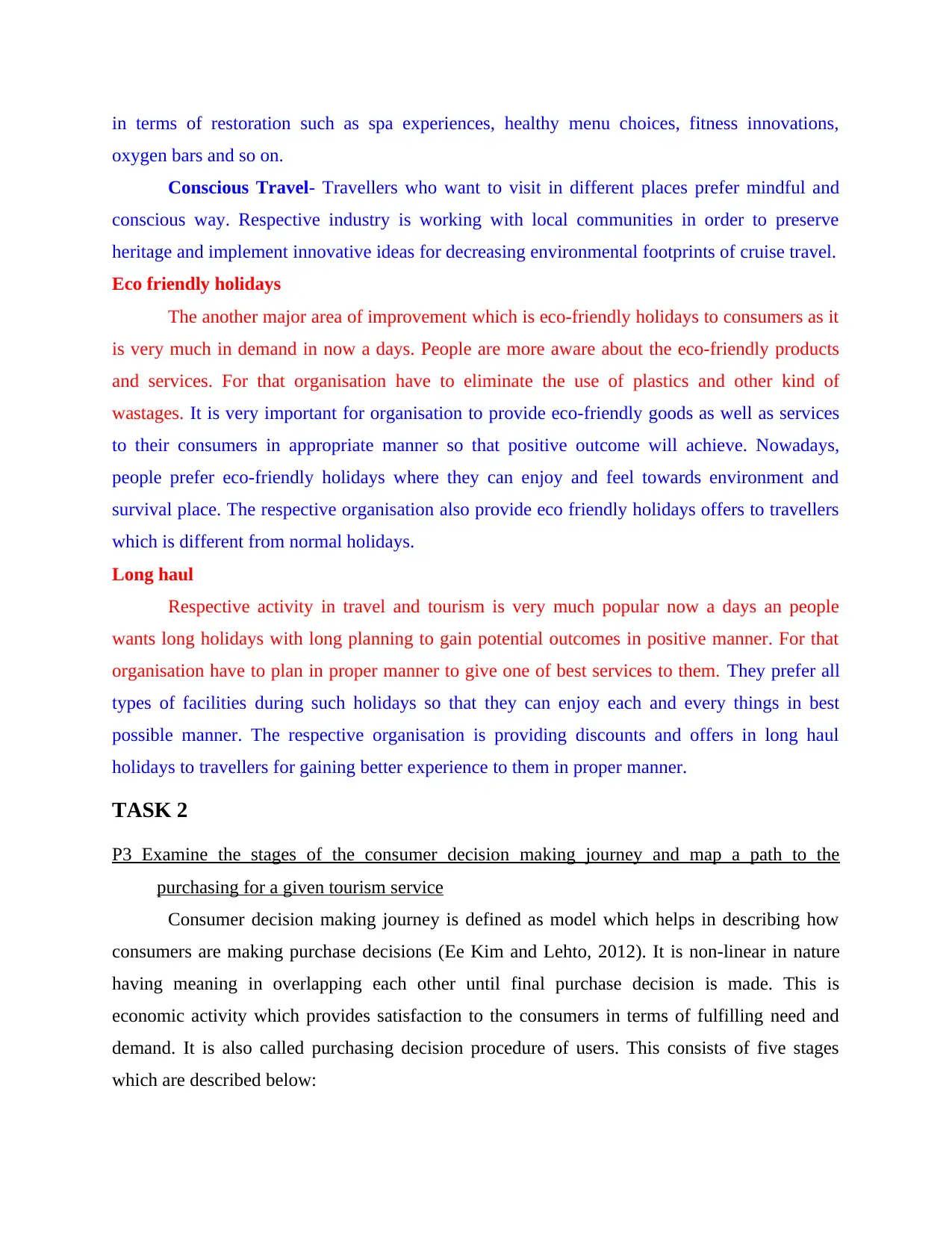
in terms of restoration such as spa experiences, healthy menu choices, fitness innovations,
oxygen bars and so on.
Conscious Travel- Travellers who want to visit in different places prefer mindful and
conscious way. Respective industry is working with local communities in order to preserve
heritage and implement innovative ideas for decreasing environmental footprints of cruise travel.
Eco friendly holidays
The another major area of improvement which is eco-friendly holidays to consumers as it
is very much in demand in now a days. People are more aware about the eco-friendly products
and services. For that organisation have to eliminate the use of plastics and other kind of
wastages. It is very important for organisation to provide eco-friendly goods as well as services
to their consumers in appropriate manner so that positive outcome will achieve. Nowadays,
people prefer eco-friendly holidays where they can enjoy and feel towards environment and
survival place. The respective organisation also provide eco friendly holidays offers to travellers
which is different from normal holidays.
Long haul
Respective activity in travel and tourism is very much popular now a days an people
wants long holidays with long planning to gain potential outcomes in positive manner. For that
organisation have to plan in proper manner to give one of best services to them. They prefer all
types of facilities during such holidays so that they can enjoy each and every things in best
possible manner. The respective organisation is providing discounts and offers in long haul
holidays to travellers for gaining better experience to them in proper manner.
TASK 2
P3 Examine the stages of the consumer decision making journey and map a path to the
purchasing for a given tourism service
Consumer decision making journey is defined as model which helps in describing how
consumers are making purchase decisions (Ee Kim and Lehto, 2012). It is non-linear in nature
having meaning in overlapping each other until final purchase decision is made. This is
economic activity which provides satisfaction to the consumers in terms of fulfilling need and
demand. It is also called purchasing decision procedure of users. This consists of five stages
which are described below:
oxygen bars and so on.
Conscious Travel- Travellers who want to visit in different places prefer mindful and
conscious way. Respective industry is working with local communities in order to preserve
heritage and implement innovative ideas for decreasing environmental footprints of cruise travel.
Eco friendly holidays
The another major area of improvement which is eco-friendly holidays to consumers as it
is very much in demand in now a days. People are more aware about the eco-friendly products
and services. For that organisation have to eliminate the use of plastics and other kind of
wastages. It is very important for organisation to provide eco-friendly goods as well as services
to their consumers in appropriate manner so that positive outcome will achieve. Nowadays,
people prefer eco-friendly holidays where they can enjoy and feel towards environment and
survival place. The respective organisation also provide eco friendly holidays offers to travellers
which is different from normal holidays.
Long haul
Respective activity in travel and tourism is very much popular now a days an people
wants long holidays with long planning to gain potential outcomes in positive manner. For that
organisation have to plan in proper manner to give one of best services to them. They prefer all
types of facilities during such holidays so that they can enjoy each and every things in best
possible manner. The respective organisation is providing discounts and offers in long haul
holidays to travellers for gaining better experience to them in proper manner.
TASK 2
P3 Examine the stages of the consumer decision making journey and map a path to the
purchasing for a given tourism service
Consumer decision making journey is defined as model which helps in describing how
consumers are making purchase decisions (Ee Kim and Lehto, 2012). It is non-linear in nature
having meaning in overlapping each other until final purchase decision is made. This is
economic activity which provides satisfaction to the consumers in terms of fulfilling need and
demand. It is also called purchasing decision procedure of users. This consists of five stages
which are described below:
⊘ This is a preview!⊘
Do you want full access?
Subscribe today to unlock all pages.

Trusted by 1+ million students worldwide
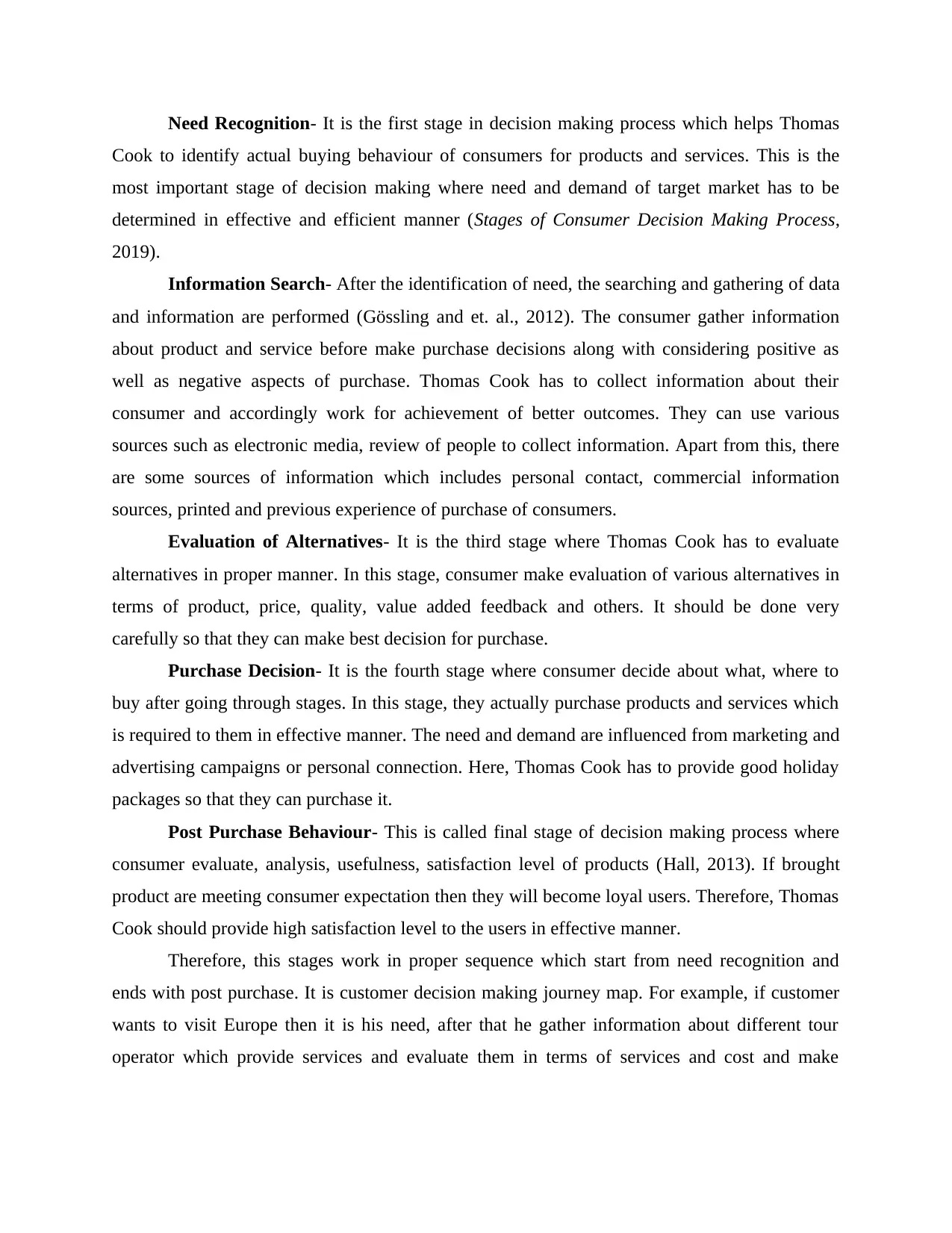
Need Recognition- It is the first stage in decision making process which helps Thomas
Cook to identify actual buying behaviour of consumers for products and services. This is the
most important stage of decision making where need and demand of target market has to be
determined in effective and efficient manner (Stages of Consumer Decision Making Process,
2019).
Information Search- After the identification of need, the searching and gathering of data
and information are performed (Gössling and et. al., 2012). The consumer gather information
about product and service before make purchase decisions along with considering positive as
well as negative aspects of purchase. Thomas Cook has to collect information about their
consumer and accordingly work for achievement of better outcomes. They can use various
sources such as electronic media, review of people to collect information. Apart from this, there
are some sources of information which includes personal contact, commercial information
sources, printed and previous experience of purchase of consumers.
Evaluation of Alternatives- It is the third stage where Thomas Cook has to evaluate
alternatives in proper manner. In this stage, consumer make evaluation of various alternatives in
terms of product, price, quality, value added feedback and others. It should be done very
carefully so that they can make best decision for purchase.
Purchase Decision- It is the fourth stage where consumer decide about what, where to
buy after going through stages. In this stage, they actually purchase products and services which
is required to them in effective manner. The need and demand are influenced from marketing and
advertising campaigns or personal connection. Here, Thomas Cook has to provide good holiday
packages so that they can purchase it.
Post Purchase Behaviour- This is called final stage of decision making process where
consumer evaluate, analysis, usefulness, satisfaction level of products (Hall, 2013). If brought
product are meeting consumer expectation then they will become loyal users. Therefore, Thomas
Cook should provide high satisfaction level to the users in effective manner.
Therefore, this stages work in proper sequence which start from need recognition and
ends with post purchase. It is customer decision making journey map. For example, if customer
wants to visit Europe then it is his need, after that he gather information about different tour
operator which provide services and evaluate them in terms of services and cost and make
Cook to identify actual buying behaviour of consumers for products and services. This is the
most important stage of decision making where need and demand of target market has to be
determined in effective and efficient manner (Stages of Consumer Decision Making Process,
2019).
Information Search- After the identification of need, the searching and gathering of data
and information are performed (Gössling and et. al., 2012). The consumer gather information
about product and service before make purchase decisions along with considering positive as
well as negative aspects of purchase. Thomas Cook has to collect information about their
consumer and accordingly work for achievement of better outcomes. They can use various
sources such as electronic media, review of people to collect information. Apart from this, there
are some sources of information which includes personal contact, commercial information
sources, printed and previous experience of purchase of consumers.
Evaluation of Alternatives- It is the third stage where Thomas Cook has to evaluate
alternatives in proper manner. In this stage, consumer make evaluation of various alternatives in
terms of product, price, quality, value added feedback and others. It should be done very
carefully so that they can make best decision for purchase.
Purchase Decision- It is the fourth stage where consumer decide about what, where to
buy after going through stages. In this stage, they actually purchase products and services which
is required to them in effective manner. The need and demand are influenced from marketing and
advertising campaigns or personal connection. Here, Thomas Cook has to provide good holiday
packages so that they can purchase it.
Post Purchase Behaviour- This is called final stage of decision making process where
consumer evaluate, analysis, usefulness, satisfaction level of products (Hall, 2013). If brought
product are meeting consumer expectation then they will become loyal users. Therefore, Thomas
Cook should provide high satisfaction level to the users in effective manner.
Therefore, this stages work in proper sequence which start from need recognition and
ends with post purchase. It is customer decision making journey map. For example, if customer
wants to visit Europe then it is his need, after that he gather information about different tour
operator which provide services and evaluate them in terms of services and cost and make
Paraphrase This Document
Need a fresh take? Get an instant paraphrase of this document with our AI Paraphraser
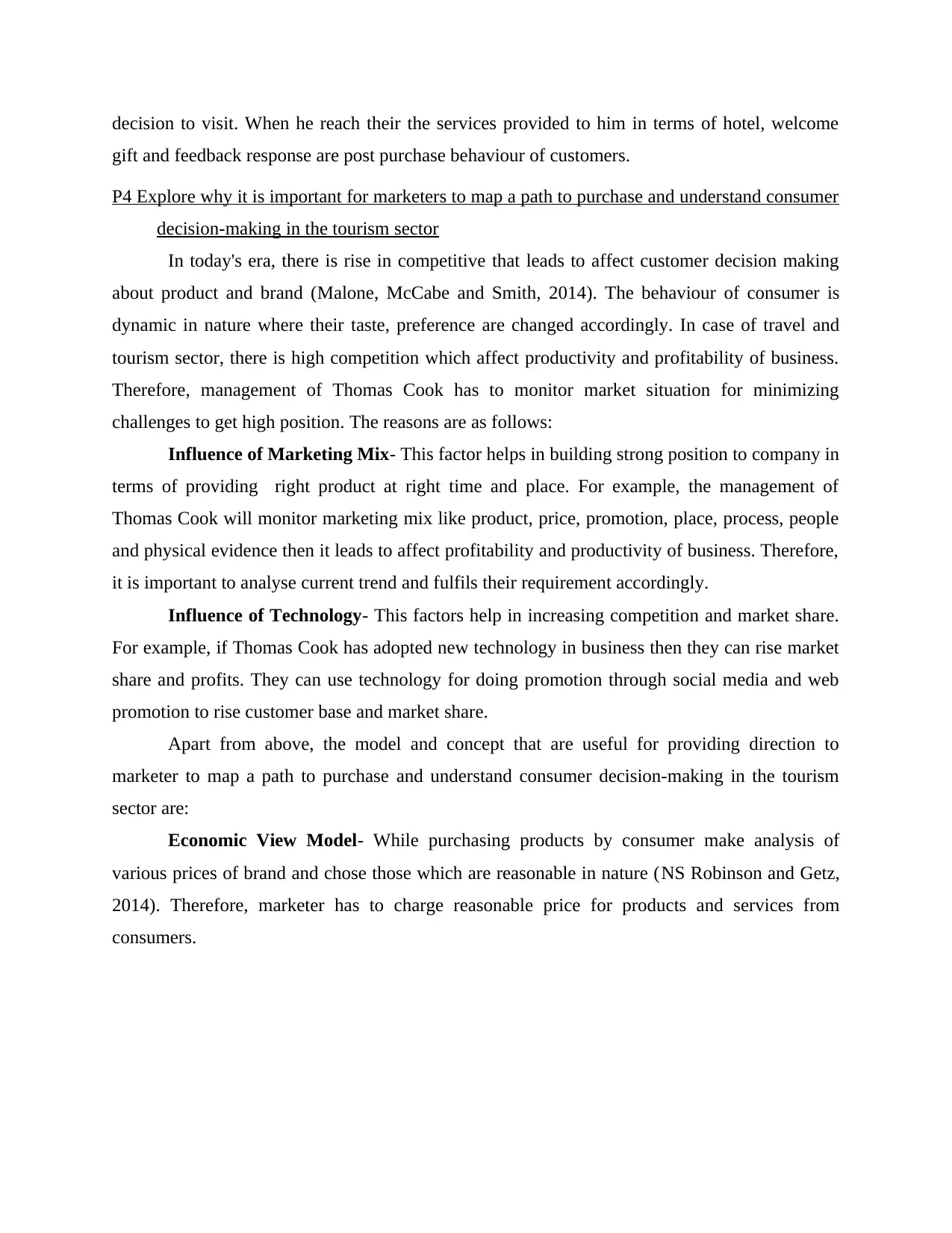
decision to visit. When he reach their the services provided to him in terms of hotel, welcome
gift and feedback response are post purchase behaviour of customers.
P4 Explore why it is important for marketers to map a path to purchase and understand consumer
decision-making in the tourism sector
In today's era, there is rise in competitive that leads to affect customer decision making
about product and brand (Malone, McCabe and Smith, 2014). The behaviour of consumer is
dynamic in nature where their taste, preference are changed accordingly. In case of travel and
tourism sector, there is high competition which affect productivity and profitability of business.
Therefore, management of Thomas Cook has to monitor market situation for minimizing
challenges to get high position. The reasons are as follows:
Influence of Marketing Mix- This factor helps in building strong position to company in
terms of providing right product at right time and place. For example, the management of
Thomas Cook will monitor marketing mix like product, price, promotion, place, process, people
and physical evidence then it leads to affect profitability and productivity of business. Therefore,
it is important to analyse current trend and fulfils their requirement accordingly.
Influence of Technology- This factors help in increasing competition and market share.
For example, if Thomas Cook has adopted new technology in business then they can rise market
share and profits. They can use technology for doing promotion through social media and web
promotion to rise customer base and market share.
Apart from above, the model and concept that are useful for providing direction to
marketer to map a path to purchase and understand consumer decision-making in the tourism
sector are:
Economic View Model- While purchasing products by consumer make analysis of
various prices of brand and chose those which are reasonable in nature (NS Robinson and Getz,
2014). Therefore, marketer has to charge reasonable price for products and services from
consumers.
gift and feedback response are post purchase behaviour of customers.
P4 Explore why it is important for marketers to map a path to purchase and understand consumer
decision-making in the tourism sector
In today's era, there is rise in competitive that leads to affect customer decision making
about product and brand (Malone, McCabe and Smith, 2014). The behaviour of consumer is
dynamic in nature where their taste, preference are changed accordingly. In case of travel and
tourism sector, there is high competition which affect productivity and profitability of business.
Therefore, management of Thomas Cook has to monitor market situation for minimizing
challenges to get high position. The reasons are as follows:
Influence of Marketing Mix- This factor helps in building strong position to company in
terms of providing right product at right time and place. For example, the management of
Thomas Cook will monitor marketing mix like product, price, promotion, place, process, people
and physical evidence then it leads to affect profitability and productivity of business. Therefore,
it is important to analyse current trend and fulfils their requirement accordingly.
Influence of Technology- This factors help in increasing competition and market share.
For example, if Thomas Cook has adopted new technology in business then they can rise market
share and profits. They can use technology for doing promotion through social media and web
promotion to rise customer base and market share.
Apart from above, the model and concept that are useful for providing direction to
marketer to map a path to purchase and understand consumer decision-making in the tourism
sector are:
Economic View Model- While purchasing products by consumer make analysis of
various prices of brand and chose those which are reasonable in nature (NS Robinson and Getz,
2014). Therefore, marketer has to charge reasonable price for products and services from
consumers.

TASK 3
P5 Compare and contrast key differences of hospitality decision-making process in context of
B2C and B2B
In context of marketing function, B2C and B2B are regarded as form of commercial
transaction (Prebensen, Chen and Uysal, 2018). Here, B2C means business to customer where
organisation sell their product to customers. Similarly, B2B means business to business where
organisation sell their products to business. The difference among B2C and B2B are described
below:
Particulars B2C B2B
Purchasing decision In B2C, customer are regarded as
most significant factor where they
make judgement about buying of
goods and services of organisation.
This requires less time for doing
business transaction. As customer
directly buy products from
business without any interferences.
In B2B, before providing any
products to business, Thomas
Cook has to evaluate various
components such as pricing
strategies, nature of consumers.
It is very important to gather
proper data and information
about business which is
required to them in effective
manner so that better
improvement can be made.
Finding out needs In this stage, it is the responsibility
of management to analyse market
for their consumers so that they
can identify their needs and
demand and provide them
accordingly. They have to use
advertisement channels to create
awareness and gain attention of
consumers.
In B2B, they has to place their
participation in order to monitor
market condition for providing
services to business. They have
to analyse and identify need and
demand of business which is
required to run enterprise
successfully.
Decision related to In B2C, it is the management In B2B, Thomas Cook has to
P5 Compare and contrast key differences of hospitality decision-making process in context of
B2C and B2B
In context of marketing function, B2C and B2B are regarded as form of commercial
transaction (Prebensen, Chen and Uysal, 2018). Here, B2C means business to customer where
organisation sell their product to customers. Similarly, B2B means business to business where
organisation sell their products to business. The difference among B2C and B2B are described
below:
Particulars B2C B2B
Purchasing decision In B2C, customer are regarded as
most significant factor where they
make judgement about buying of
goods and services of organisation.
This requires less time for doing
business transaction. As customer
directly buy products from
business without any interferences.
In B2B, before providing any
products to business, Thomas
Cook has to evaluate various
components such as pricing
strategies, nature of consumers.
It is very important to gather
proper data and information
about business which is
required to them in effective
manner so that better
improvement can be made.
Finding out needs In this stage, it is the responsibility
of management to analyse market
for their consumers so that they
can identify their needs and
demand and provide them
accordingly. They have to use
advertisement channels to create
awareness and gain attention of
consumers.
In B2B, they has to place their
participation in order to monitor
market condition for providing
services to business. They have
to analyse and identify need and
demand of business which is
required to run enterprise
successfully.
Decision related to In B2C, it is the management In B2B, Thomas Cook has to
⊘ This is a preview!⊘
Do you want full access?
Subscribe today to unlock all pages.

Trusted by 1+ million students worldwide

market size responsibility to cover vast area in
order to provide services. This
helps in getting attention of large
consumer to avail services and
facilities that leads to rise in
profits.
segment market on basis of
lifestyle, age, income level,
occupation and so on. Also they
can segment it in small group to
fulfil their need and
requirement in effective manner
for positive outcomes.
Therefore, the above difference among B2C and B2B assist Thomas Cook for
identification of respective sector and collect data and information to enhance profitability.
P6 Evaluate the different approaches to market research and methods of research used for
understanding the decision making process
In order to survive and sustain at marketplace, it is very important to investigate about
need and demand of consumers in an effective manner (Santos and Ramos, 2014). Thomas Cook
has used both business B2C and B2B market research that are given below:
Market Research Approach in B2C
Marketers are collecting information from primary method as it provide first hand and
fresh data to reduce issues and problems. The source of this method are:
Questionnaire- In this source, researcher design questionnaire in order to get information
that assist in improving value of organisation and effectiveness of assignment.
Personal Interview- In this source, researcher conduct face to face interview with people
to know about their perception and view regarding products and service of respective
organisation. With this consumer decision making process can be understood.
Market Research Approach in B2B
Under this market research approach, data and information are collected from already
published source on website, companies and internet which is called secondary method
(Schanzel and et. al., 2012). It can be used for future time period. The sources of this method are:
Public Records- Thomas Cook determine past performance and records between market
and consumer to get proper data and information and accordingly analyse decision making
process.
Government and Non-Government Agencies- Thomas Cook has to view all
government and non-government agencies, policies and process in order to make brand image at
order to provide services. This
helps in getting attention of large
consumer to avail services and
facilities that leads to rise in
profits.
segment market on basis of
lifestyle, age, income level,
occupation and so on. Also they
can segment it in small group to
fulfil their need and
requirement in effective manner
for positive outcomes.
Therefore, the above difference among B2C and B2B assist Thomas Cook for
identification of respective sector and collect data and information to enhance profitability.
P6 Evaluate the different approaches to market research and methods of research used for
understanding the decision making process
In order to survive and sustain at marketplace, it is very important to investigate about
need and demand of consumers in an effective manner (Santos and Ramos, 2014). Thomas Cook
has used both business B2C and B2B market research that are given below:
Market Research Approach in B2C
Marketers are collecting information from primary method as it provide first hand and
fresh data to reduce issues and problems. The source of this method are:
Questionnaire- In this source, researcher design questionnaire in order to get information
that assist in improving value of organisation and effectiveness of assignment.
Personal Interview- In this source, researcher conduct face to face interview with people
to know about their perception and view regarding products and service of respective
organisation. With this consumer decision making process can be understood.
Market Research Approach in B2B
Under this market research approach, data and information are collected from already
published source on website, companies and internet which is called secondary method
(Schanzel and et. al., 2012). It can be used for future time period. The sources of this method are:
Public Records- Thomas Cook determine past performance and records between market
and consumer to get proper data and information and accordingly analyse decision making
process.
Government and Non-Government Agencies- Thomas Cook has to view all
government and non-government agencies, policies and process in order to make brand image at
Paraphrase This Document
Need a fresh take? Get an instant paraphrase of this document with our AI Paraphraser
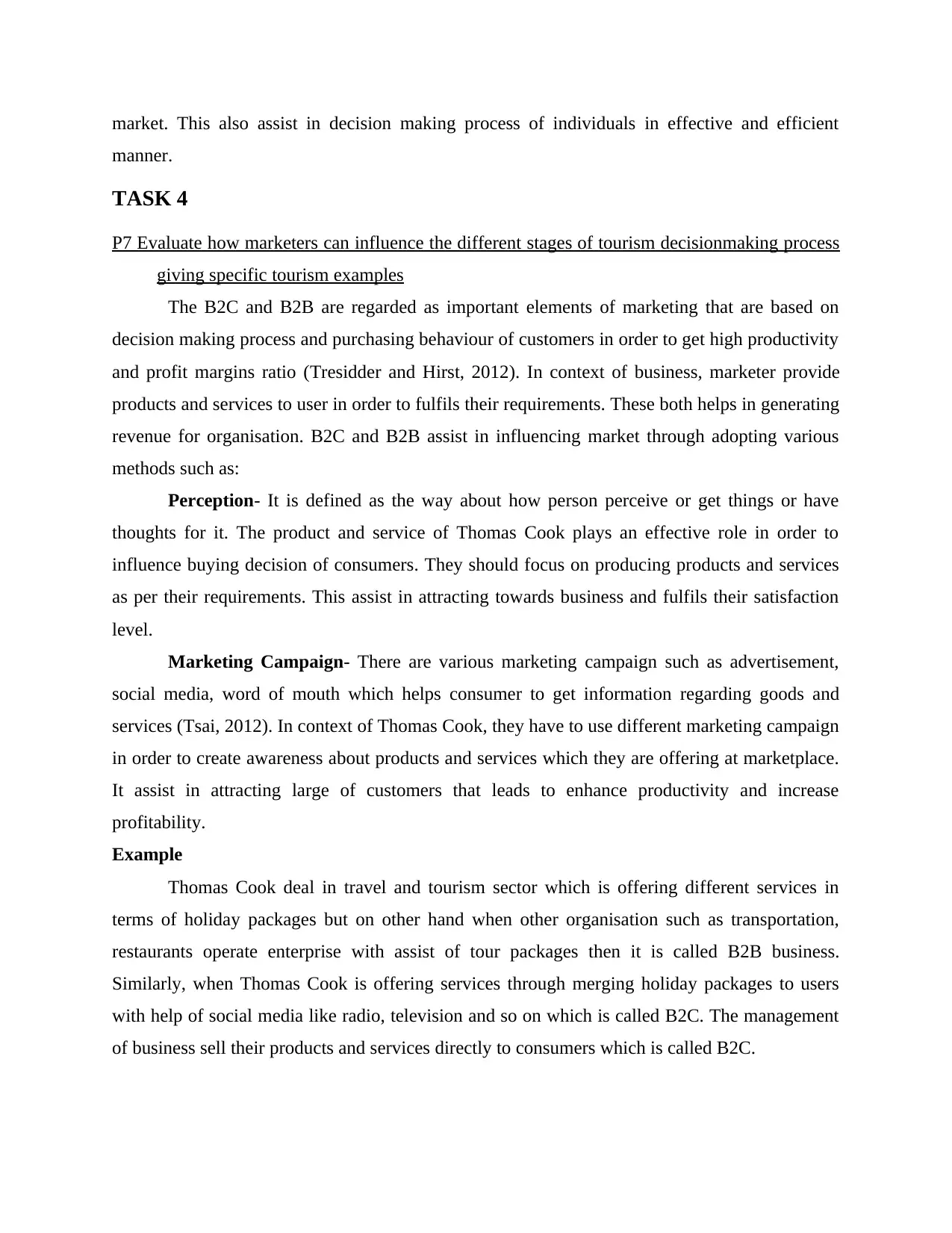
market. This also assist in decision making process of individuals in effective and efficient
manner.
TASK 4
P7 Evaluate how marketers can influence the different stages of tourism decisionmaking process
giving specific tourism examples
The B2C and B2B are regarded as important elements of marketing that are based on
decision making process and purchasing behaviour of customers in order to get high productivity
and profit margins ratio (Tresidder and Hirst, 2012). In context of business, marketer provide
products and services to user in order to fulfils their requirements. These both helps in generating
revenue for organisation. B2C and B2B assist in influencing market through adopting various
methods such as:
Perception- It is defined as the way about how person perceive or get things or have
thoughts for it. The product and service of Thomas Cook plays an effective role in order to
influence buying decision of consumers. They should focus on producing products and services
as per their requirements. This assist in attracting towards business and fulfils their satisfaction
level.
Marketing Campaign- There are various marketing campaign such as advertisement,
social media, word of mouth which helps consumer to get information regarding goods and
services (Tsai, 2012). In context of Thomas Cook, they have to use different marketing campaign
in order to create awareness about products and services which they are offering at marketplace.
It assist in attracting large of customers that leads to enhance productivity and increase
profitability.
Example
Thomas Cook deal in travel and tourism sector which is offering different services in
terms of holiday packages but on other hand when other organisation such as transportation,
restaurants operate enterprise with assist of tour packages then it is called B2B business.
Similarly, when Thomas Cook is offering services through merging holiday packages to users
with help of social media like radio, television and so on which is called B2C. The management
of business sell their products and services directly to consumers which is called B2C.
manner.
TASK 4
P7 Evaluate how marketers can influence the different stages of tourism decisionmaking process
giving specific tourism examples
The B2C and B2B are regarded as important elements of marketing that are based on
decision making process and purchasing behaviour of customers in order to get high productivity
and profit margins ratio (Tresidder and Hirst, 2012). In context of business, marketer provide
products and services to user in order to fulfils their requirements. These both helps in generating
revenue for organisation. B2C and B2B assist in influencing market through adopting various
methods such as:
Perception- It is defined as the way about how person perceive or get things or have
thoughts for it. The product and service of Thomas Cook plays an effective role in order to
influence buying decision of consumers. They should focus on producing products and services
as per their requirements. This assist in attracting towards business and fulfils their satisfaction
level.
Marketing Campaign- There are various marketing campaign such as advertisement,
social media, word of mouth which helps consumer to get information regarding goods and
services (Tsai, 2012). In context of Thomas Cook, they have to use different marketing campaign
in order to create awareness about products and services which they are offering at marketplace.
It assist in attracting large of customers that leads to enhance productivity and increase
profitability.
Example
Thomas Cook deal in travel and tourism sector which is offering different services in
terms of holiday packages but on other hand when other organisation such as transportation,
restaurants operate enterprise with assist of tour packages then it is called B2B business.
Similarly, when Thomas Cook is offering services through merging holiday packages to users
with help of social media like radio, television and so on which is called B2C. The management
of business sell their products and services directly to consumers which is called B2C.
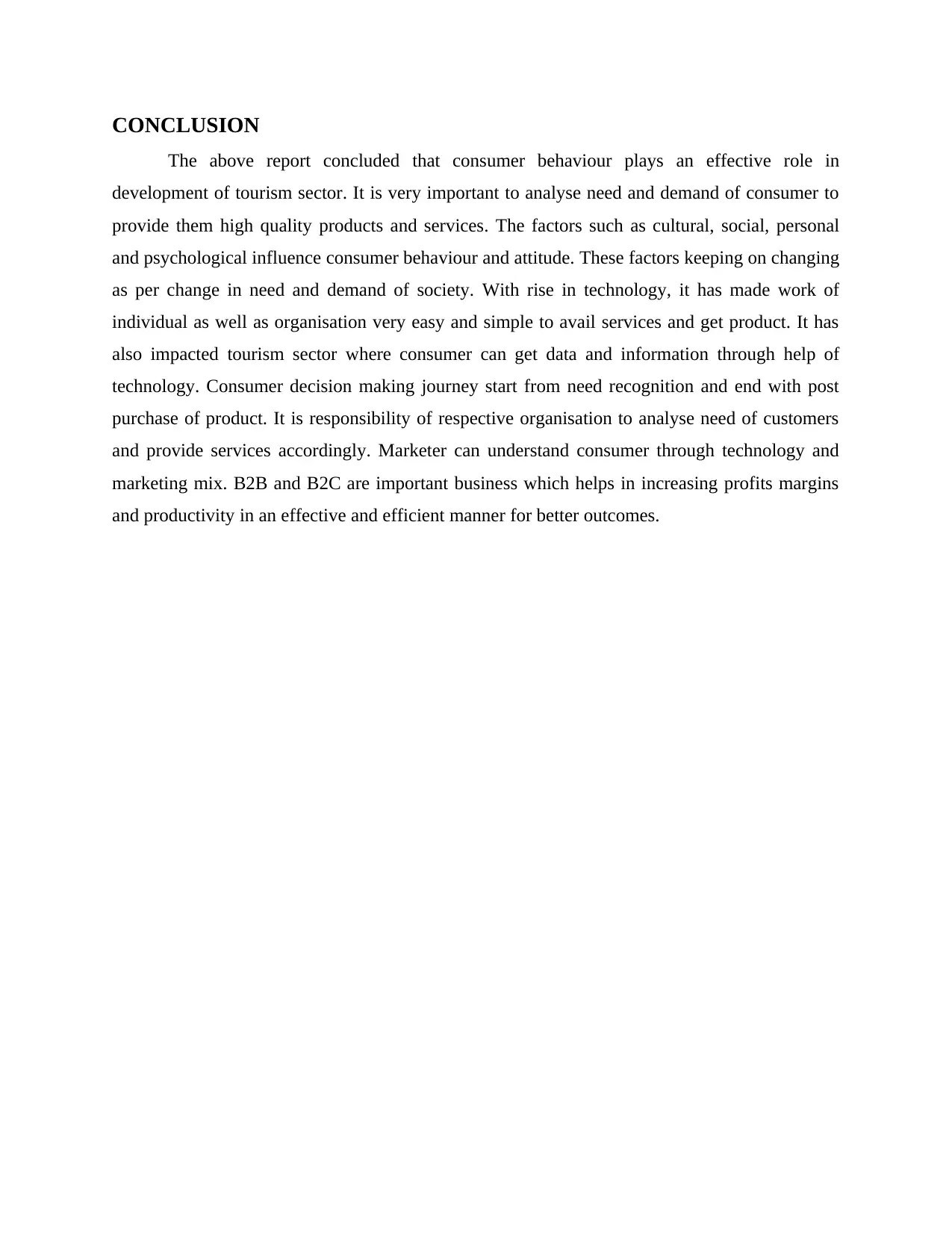
CONCLUSION
The above report concluded that consumer behaviour plays an effective role in
development of tourism sector. It is very important to analyse need and demand of consumer to
provide them high quality products and services. The factors such as cultural, social, personal
and psychological influence consumer behaviour and attitude. These factors keeping on changing
as per change in need and demand of society. With rise in technology, it has made work of
individual as well as organisation very easy and simple to avail services and get product. It has
also impacted tourism sector where consumer can get data and information through help of
technology. Consumer decision making journey start from need recognition and end with post
purchase of product. It is responsibility of respective organisation to analyse need of customers
and provide services accordingly. Marketer can understand consumer through technology and
marketing mix. B2B and B2C are important business which helps in increasing profits margins
and productivity in an effective and efficient manner for better outcomes.
The above report concluded that consumer behaviour plays an effective role in
development of tourism sector. It is very important to analyse need and demand of consumer to
provide them high quality products and services. The factors such as cultural, social, personal
and psychological influence consumer behaviour and attitude. These factors keeping on changing
as per change in need and demand of society. With rise in technology, it has made work of
individual as well as organisation very easy and simple to avail services and get product. It has
also impacted tourism sector where consumer can get data and information through help of
technology. Consumer decision making journey start from need recognition and end with post
purchase of product. It is responsibility of respective organisation to analyse need of customers
and provide services accordingly. Marketer can understand consumer through technology and
marketing mix. B2B and B2C are important business which helps in increasing profits margins
and productivity in an effective and efficient manner for better outcomes.
⊘ This is a preview!⊘
Do you want full access?
Subscribe today to unlock all pages.

Trusted by 1+ million students worldwide
1 out of 14
Related Documents
Your All-in-One AI-Powered Toolkit for Academic Success.
+13062052269
info@desklib.com
Available 24*7 on WhatsApp / Email
![[object Object]](/_next/static/media/star-bottom.7253800d.svg)
Unlock your academic potential
Copyright © 2020–2025 A2Z Services. All Rights Reserved. Developed and managed by ZUCOL.





